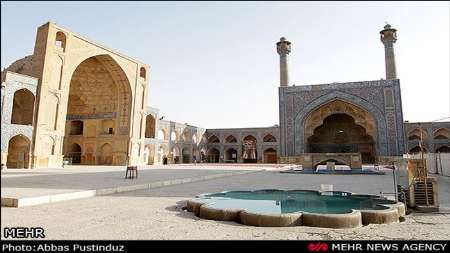
The complex, extending over 20,000 square meters, is the first Islamic building that adapted the four-iwan structure of Sassanid palaces to Islamic religious architecture. Its double-shelled ribbed domes represent an architectural innovation that inspired architects throughout the region. The site also features remarkable decorative details of Islamic art, Tehran-based English newspaper, Iran Daily, reported.
The monument exemplifies a sequence of architectural construction and decorative styles of different periods in Iranian-Islamic architecture, most predominantly the Abbasid, Al-e Bouyeh, Seljuk, Ilkhanid, Mozaffarid, Teymurid and Safavid eras. Following its expansion during the Seljuk era and the introduction of the four-iwan arrangement around the courtyard as well as two extraordinary domes, the mosque became the prototype of a distinctive Islamic architectural style.
An iwan is a vaulted open room. The iwan on the southern side of the mosque, facing the Grand Mosque of Makkah, was vaulted with muqarnas. Muqarnas are niche-like cells.
The prototype character is well illustrated in the earliest double-shell ribbed Nezam-ol-Molk Dome - the first instance of the four-iwan structure in Islamic architecture.
Isfahan Jame’ Mosque is an outstanding example of innovation in architectural adaptation and technology applied during the restoration and expansion of the former building during the Seljuk era, which has been further enlarged during Islamic periods with the addition of high-quality extensions and decorations.
The Nezam-ol-Molk Dome is the first double-shell ribbed dome structure in the Islamic world, which introduced new architectural skills, allowing for more elaborate dome constructions in later mosque and burial complexes. On the basis of these two elements, Isfahan Jame’ Mosque is a recognized as a prototype for mosque design, layout and dome construction, which was referenced in several later eras of the Islamic world.
Integrity
Isfahan Jame’ Mosque follows a continuous sequence of Islamic architectural styles, the most prominent of which date back to the Seljuk period. The remains from the Seljuk era, especially the key elements of the ground plan, the four iwans, and the two domes are sufficient to illustrate the advances made in mosque and dome architecture of that time. The boundaries of the estate are enough to take in the entire mosque complex with all its extensions and significant functions over the time. However, the environs of the estate is highly vulnerable to development projects.
Authenticity
Most elements of the mosque, particularly the four iwans and the Malek-ol-Molk and Taj-ol-Molk domes, are authentic in material, design and location.
Isfahan’s historical center was under heavy aerial attack during 1980-88 Iraqi-imposed war. According to a report drawn up by Iran Cultural Heritage, Handicrafts and Tourism Organization (ICHHTO), Isfahan’s Jame’ Mosque suffered serious damages during Iraqi air raids.
One rocket fell near the southern dome while another struck close to the northern dome destroying areas as wide as 2,000 meters. As a result, parts of Arab Bazaar, Shabestan (covered part of the mosque) and sections of Majlesi Bazaar and a caravanserai were destroyed.
Isfahan’s Jame’ Mosque is of high importance in terms of Iran’s architectural history.
Also, other mosques, monuments and historical houses were destroyed in Isfahan such as Dardasht marketplace, Aqa Noor Mosque (pertaining to Safavid era), Haj Mohammad Ja’far Abadehi Mosque, Sheikholeslam House (belonging to Qajar era), as well as Semsar and Ranaie historical houses. In addition, Ali-Qapu Palace and Imam Mosque faced waves of bombardments and shelling.
Restoration and a reconstruction, which became necessary following Iraq’s air raid in 1984, were conducted according to adequate standards using traditional craftsmanship and materials. One of the most important aspects of authenticity is the function of Isfahan Jame’ Mosque, both as a mosque - which if still used for prayers - and as a component of the Isfahan historic bazaar.
Attached to and accessed from the network of streets in the bazaar area, the mosque has a significant setting, the authenticity of which is highly vulnerable to changes in urban characteristics.
To respect the authenticity of the building, the museum function of mosque should remain responsive to its religious use, both in terms of information panel design and number of visitors.
Isfahan Jame’ Mosque was registered as No. 95 on National Heritage List in 1932. Also, its buffer zone is protected by regulations enforced by ICHHTO, following a cabinet decision in 2001, which stipulates that buffer zones fall under national law. Yet, it is essential that the designated property and buffer zone be integrated in the zoning bylaws.
Isfahan province, which stretches over 107,000 square kilometers, boasts a four-season climate, and thousands of historical and cultural monuments. The city of Isfahan is among the top 10 sightseeing cities. There are over 20,000 identified monuments across the province, of which 1,800 have been registered on the National Heritage List and four on World Heritage List.

Add new comment